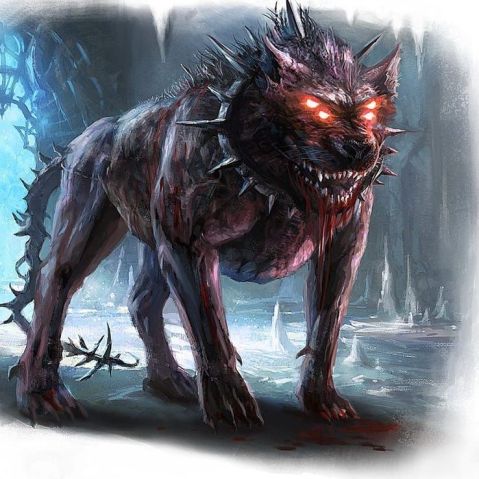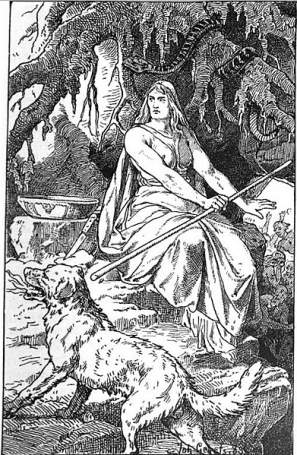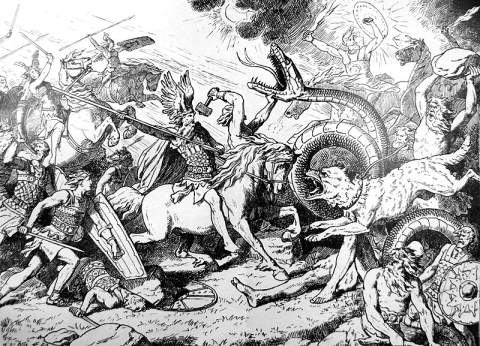Old Norse mythology offers a captivating world full of gods, giants, and magical creatures. In this realm, one cannot overlook Garm, the ferocious hound guarding the entrance to the underworld Helheim. Diving into the myths of Garm you will learn more about the goddess Hel as well.
Etymolygy and Origins of Garm
Derived from Old Norse, “Garm” or “Garmr” likely comes from the verb “gjarma,” which means “to howl” or “to yelp.” A fitting name for a hound known to evoke terror in the hearts of those who dare approach it. In Norse mythology, Garm finds himself in the company of other hounds and wolves, such as the infamous Fenrir and the elusive brothers Sköll and Hati.
Norse myths do not exclusively claim the notion of a powerful, otherworldly hound. Various Indo-European mythological traditions also feature these fearsome guardians, indicating a deep-rooted cultural fascination with them.
Description and Physical Features
Old Norse literature often portrays Garm as a monstrous hound with blood-stained fur, a testament to its menacing presence. Its harrowing features and characteristics serve as a reminder of the inevitability of death and the terrors of the underworld. As a result, Garm’s dark nature has fascinated and inspired artistic minds for generations.

Both ancient carvings and contemporary art have depicted Garm, capturing its essence as a symbol of the darker aspects of Norse mythology. The hound’s fearsome visage continues to captivate our imagination, bridging the gap between the ancient and the modern world.
Found in the so-called Edda Oblongata, the poem Vegtamskvida is a longer version of the Poetic Edda poem Baldrs Draumar. In stanza 6 and 7 we get a good idea of how Garmr looks.
- Odin rose, lord of men and he saddled Sleipnir; then he rode down to Niflhel.
There he met a dog that came from Hel. - It was blood stained on its breast, its slaughter-craving throat, and lower jaw.
It bayed and widely gaped at the sire of the magic song (Odin):—long it howled.
While Garm isn’t named in this reference it is clear that it’s him. As I’ll share below other references place him in a cave at the very gate to Hel, guarding it always.
Evil, yet still the best of hounds
In the warrior culture of the Viking Age, people regard Garm as the “Best of hounds.” Despite his portrayal as a bloodthirsty beast and evil guardian to Hel, this admiration reflects a deeper concept within the Vikings: respecting the strongest and bravest, whether friend or foe.
In the Grímnismál, another poem in the Poetic Edda, we find the reference to Garm as the best hound.
- “The ash Yggdrasil | is the greatest tree,
Skidbladnir best of ships;
Odin of all gods, of horses Sleipnir,
Bifrost of bridges,| Bragi of poets,
Hábrók of hawks, and Garmr of hounds.”
Garm and the Realm of Hel
The realm of Hel, where the dead reside, is governed by the goddess Hel, who shares its name. Garm makes his home in Gnipahellir, a cave situated near Hel’s entrance. Here, the hound vigilantly stands guard, barring the living from trespassing and preventing the dead from leaving the underworld.

Garm and his cave, Gnipahellir, is mentioned in a couple of old texts. One such mention is in the Poetic Edda poem Völuspá, stanza 48 (or 44 depending on the translation)
“Now Garm howls loud | before Gnipahellir,
The fetters will burst, | and the wolf run free;
Much do I know, | and more can see
Of the fate of the gods, | the mighty in fight.”
(Henry Adams Bellows translation)
Garm and Cerberus Greek Hound of Hades
A striking parallel can be drawn between Garm and Cerberus, the hound that guards the Greek underworld, Hades. Exploring the similarities and differences between these two mythical creatures provides insight into how different cultures depict guardians of the afterlife and the influence of their beliefs on these portrayals. This passage also reminds us that despite their distinct Norse origins, Christians influenced by Greek mythology wrote down many of these stories.
At their core, Garm and Cerberus both actively guard the entrances to their respective underworlds. As fierce, monstrous hounds, they instill fear in anyone who dares to approach them. Consequently, their primary function is to actively prevent the living from entering and the dead from escaping. This, in turn, highlights the importance of maintaining the boundaries between the worlds.
The End of the World: Garm and Ragnarök
Ragnarök, the prophesized cataclysm that heralds the end of the world, looms large in Norse mythology. Garm plays a critical role in these events, as he breaks free from his chains and joins the forces of chaos, contributing to cosmic disorder.

Garm’s actions during and after Ragnarök hold great significance, demonstrating the hound’s impact on the fate of the Norse universe. As we delve into the events surrounding the end of the world, it seems fitting how he meets his end.
This is mentioned briefly in Gylfaginning, towards the end when Snorri takes stock of the gods and how they fall. Here we learn that Garm and Tyr will kill each other in a final battle.
“Even the dog Garm, that was bound before the Gnipa-cave, gets loose. He is the greatest plague. He contends with Tyr, and they kill each other.”
Garm’s Relationship with Tyr
Garm’s connection with the god Tyr is an intriguing aspect of Norse mythology. As the god of war and justice, Tyr’s association with Garm holds profound implications. The two are destined to face each other in a fierce battle during Ragnarök, a conflict that will result in their mutual destruction.
Tyr, as you might know, is one-handed since he lost his right hand when the Aesir gods tricked Fenrir into being bound. It’s unclear whether Garm is really a hound or a wolf. However, it might not be a far stretch of the imagination to envision some sort of kinship between Garm and Fenrir. In such a light it makes perfect sense that Garm in the end will be the one to kill Tyr.
FAQs
Garm is a ferocious hound in Old Norse mythology, responsible for guarding the entrance to Hel, the realm of the dead. Known for its fearsome appearance, this menacing creature is notorious for its terrifying growl. Consequently, Garm serves a crucial role in preventing the living from entering Hel and, likewise, the dead from escaping.
In Old Norse literature, Garm often appears as a bloodstained, monstrous hound with a terrifying growl that echoes throughout the underworld. Consequently, the hound’s fierce appearance and relentless nature emphasize its formidable role as a guardian.
During Ragnarok, the cataclysmic end of the world in Norse mythology, Garm breaks free from its chains and engages in a deadly battle with the god Tyr. Both the fearsome hound and the god of war meet their demise in this epic confrontation.
Garm shares similarities with other hounds in Norse mythology, such as Fenrir, the monstrous wolf bound by the gods, and Skoll and Hati, the wolves that chase the sun and moon. However, Garm’s specific role as the guardian of Hel sets it apart from these other creatures.
Featured Image Credit: Lorenz Frølich, Public domain, via Wikimedia Commons
